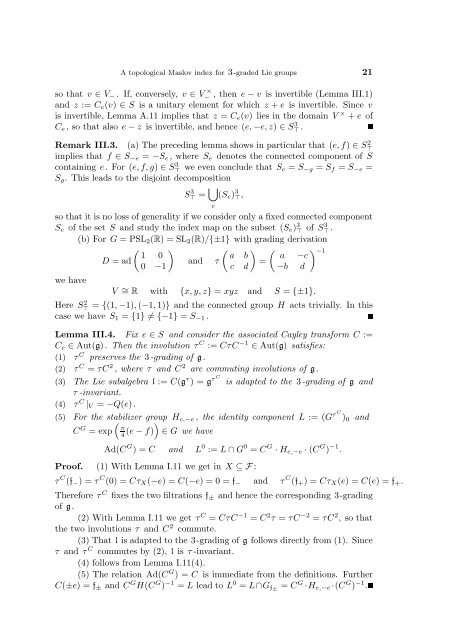A topological Maslov index for 3-graded Lie groups - ResearchGate
A topological Maslov index for 3-graded Lie groups - ResearchGate
A topological Maslov index for 3-graded Lie groups - ResearchGate
You also want an ePaper? Increase the reach of your titles
YUMPU automatically turns print PDFs into web optimized ePapers that Google loves.
A <strong>topological</strong> <strong>Maslov</strong> <strong>index</strong> <strong>for</strong> 3-<strong>graded</strong> <strong>Lie</strong> <strong>groups</strong> 21<br />
so that v ∈ V−. If, conversely, v ∈ V × − , then e − v is invertible (Lemma III.1)<br />
and z := Ce(v) ∈ S is a unitary element <strong>for</strong> which z + e is invertible. Since v<br />
is invertible, Lemma A.11 implies that z = Ce(v) lies in the domain V × + e of<br />
Ce, so that also e − z is invertible, and hence (e, −e, z) ∈ S 3 ⊤ .<br />
Remark III.3. (a) The preceding lemma shows in particular that (e, f) ∈ S 2 ⊤<br />
implies that f ∈ S−e = −Se, where Se denotes the connected component of S<br />
containing e. For (e, f, g) ∈ S 3 ⊤ we even conclude that Se = S−g = Sf = S−e =<br />
Sg. This leads to the disjoint decomposition<br />
S 3 ⊤ = <br />
(Se) 3 ⊤,<br />
e<br />
so that it is no loss of generality if we consider only a fixed connected component<br />
Se of the set S and study the <strong>index</strong> map on the subset (Se) 3 ⊤ of S3 ⊤ .<br />
we have<br />
(b) For G = PSL2(R) = SL2(R)/{±1} with grading derivation<br />
−1 1 0<br />
a b a −c<br />
D = ad and τ =<br />
0 −1<br />
c d −b d<br />
V ∼ = R with {x, y, z} = xyz and S = {±1}.<br />
Here S2 ⊤<br />
case we have S1 = {1} = {−1} = S−1.<br />
= {(1, −1), (−1, 1)} and the connected group H acts trivially. In this<br />
Lemma III.4. Fix e ∈ S and consider the associated Cayley trans<strong>for</strong>m C :=<br />
Ce ∈ Aut(g). Then the involution τC := CτC −1 ∈ Aut(g) satisfies:<br />
(1) τC preserves the 3-grading of g.<br />
(2) τC = τC2 , where τ and C2 are commuting involutions of g.<br />
(3) The <strong>Lie</strong> subalgebra l := C(gτ ) = gτC is adapted to the 3-grading of g and<br />
τ -invariant.<br />
(4) τC |V = −Q(e).<br />
(5) For the stabilizer group He,−e, the identity component L := (GτC CG <br />
π = exp (e − f) ∈ G we have<br />
4<br />
Ad(C G ) = C and L 0 := L ∩ G 0 = C G · He,−e · (C G ) −1 .<br />
Proof. (1) With Lemma I.11 we get in X ⊆ F :<br />
)0 and<br />
τ C (f−) = τ C (0) = CτX(−e) = C(−e) = 0 = f− and τ C (f+) = CτX(e) = C(e) = f+.<br />
There<strong>for</strong>e τ C fixes the two filtrations f± and hence the corresponding 3-grading<br />
of g.<br />
(2) With Lemma I.11 we get τ C = CτC −1 = C 2 τ = τC −2 = τC 2 , so that<br />
the two involutions τ and C 2 commute.<br />
(3) That l is adapted to the 3-grading of g follows directly from (1). Since<br />
τ and τ C commutes by (2), l is τ -invariant.<br />
(4) follows from Lemma I.11(4).<br />
(5) The relation Ad(C G ) = C is immediate from the definitions. Further<br />
C(±e) = f± and C G H(C G ) −1 = L lead to L 0 = L∩Gf± = CG ·He,−e ·(C G ) −1 .

















